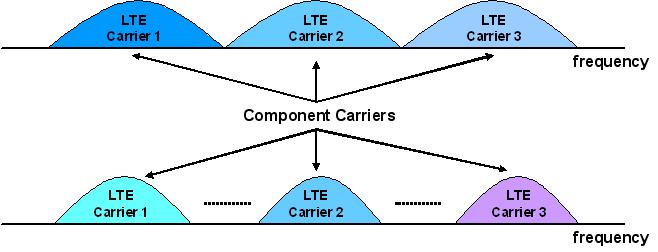To meet LTE-Advanced requirements, support of wider transmission bandwidths is required than the 20 MHz bandwidth specified in 3GPP Release 8/9. The preferred solution to this is carrier aggregation. It is of the most distinct features of 4G LTE-Advanced. Carrier aggregation allows expansion of effective bandwidth delivered to a user terminal through concurrent utilization of radio resources across multiple carriers. Multiple component carriers are aggregated to form a larger overall transmission bandwidth.
3GPP specifies carrier aggregation in LTE as following
- Rel-8/9 backward compatible carriers are the basic building blocks and to be supported
- Rel-10 signalling to support aggregation of up to 5 DL of component carriers and 5 UL of component carriers, irrespective of intra- or inter-band Carrier Aggregation (CA).
- Rel-10 to support both intra- and inter-band aggregation for both DL & UL in FDD
- Rel-10 to support inter-band aggregation with different signal reception timings across of component carriers of different bands for FDD DL
- UE-specific asymmetric number of component carriers in DL and UL
- Component carriers can have any of the bandwidths supported in Rel-8

Contiguous & non-contiguous carrier aggregation
Two or more component carriers can be aggregated to support wider transmission bandwidths up to 100 MHz. Spectrum deployment can be either contiguous or non-contiguous. Support for carrier aggregation feature requires enhancement to the 3GPP LTE Release 8 & 9 physical, MAC, and RRC protocol layers. To an LTE Release 8 terminal, each component carrier will appear as an LTE carrier, while an LTE-Advanced terminal can use the total aggregated bandwidth.
source: LteWorld


